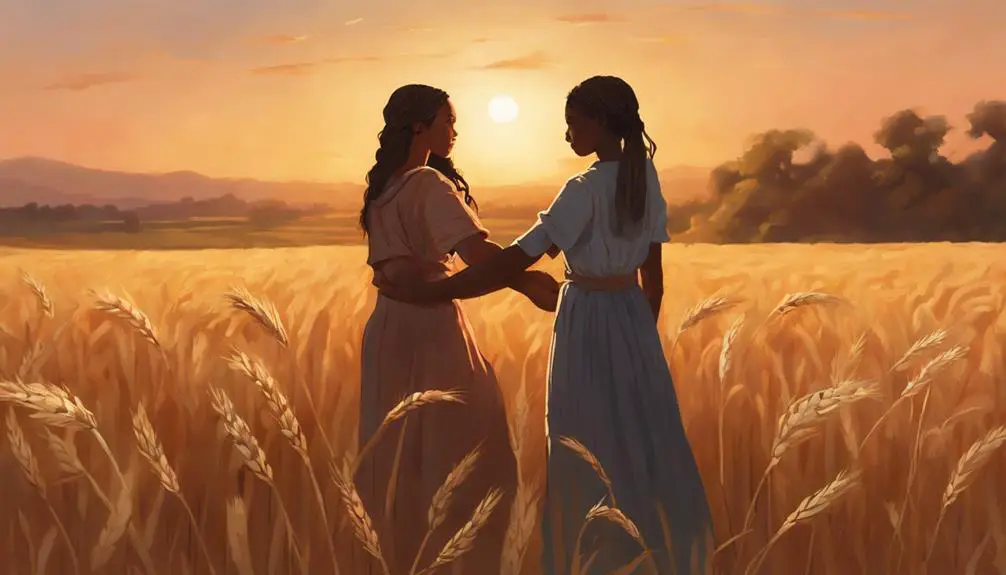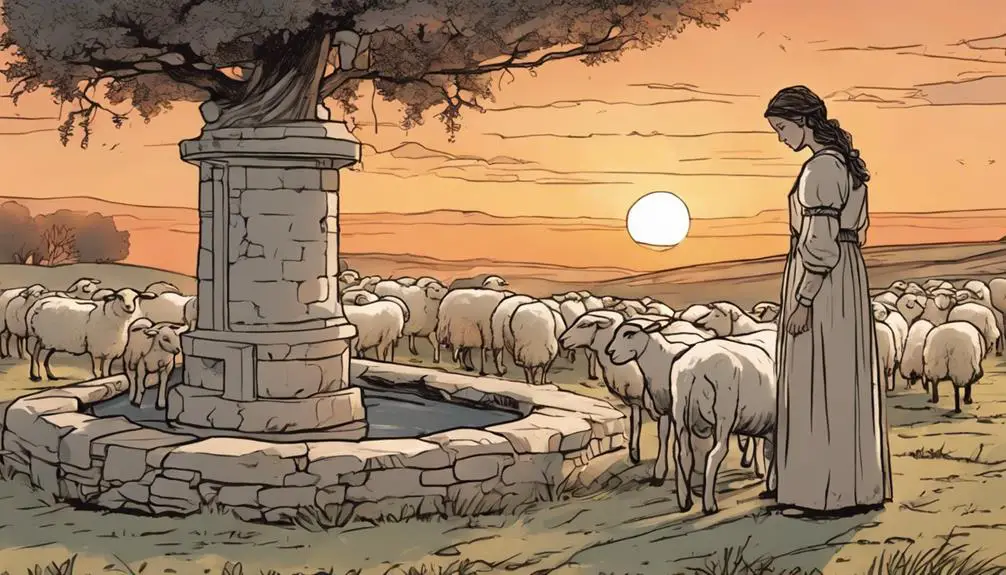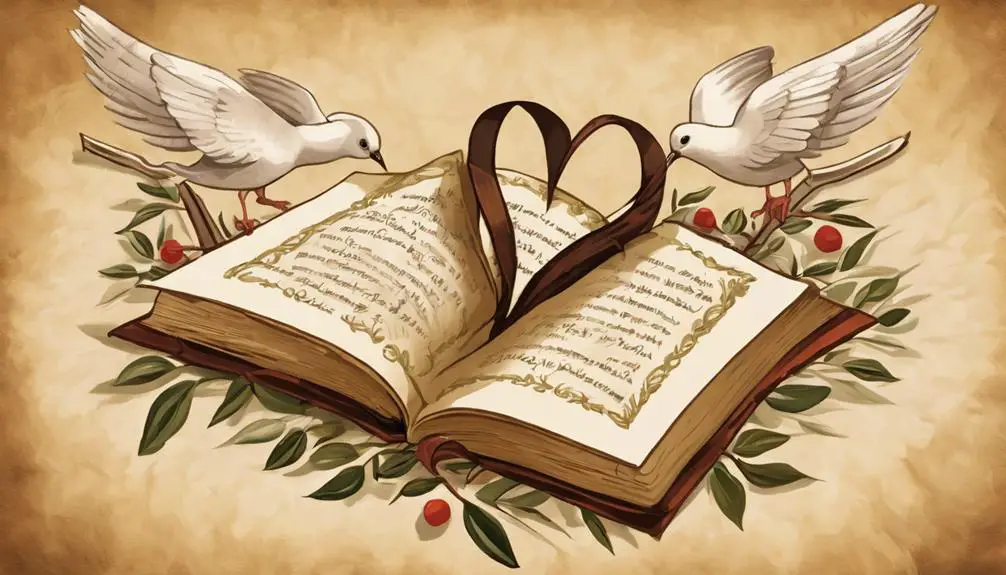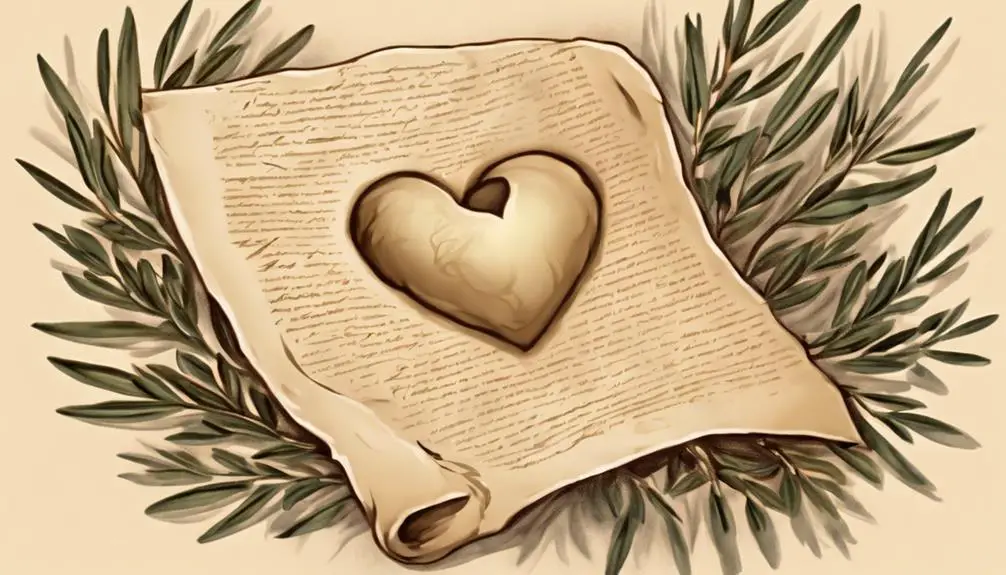Gain insight into the Bible's most heartfelt love letters, revealing timeless expressions of devotion and passion that resonate today.

Love Letters in the Bible
You might not be aware that the Bible, often seen as a collection of religious texts, houses some of the most passionate and heartfelt love letters ever written. From the poetic verses of Song of Solomon that celebrate romantic love to Ruth's unwavering devotion to Naomi, these stories offer a profound look at the nature of love in its many forms.
As you explore these biblical narratives, you'll find that the expressions of love, whether through the loyalty of Jacob for Rachel or the profound friendship between David and Jonathan, are not only deeply moving but also provide timeless insights into the human heart.
This journey through love's various expressions in the Bible may surprise you with its relevance and depth.
Key Takeaways
- Biblical narratives highlight love's diverse expressions, from romantic desire to unwavering loyalty and divine allegory.
- Paul's teachings emphasize *agape* love as the foundation for Christian community and ethical conduct.
- Love in the Bible transcends human limitations, fostering unity, endurance, and sacrificial actions among believers.
- The concept of *agape* love challenges and inspires believers to embody selfless and transformative love in all relationships.
The Passion of Song of Solomon

Within the pages of the Song of Solomon, you'll find an unparalleled expression of passion and love, capturing the essence of romantic desire through its vivid and poetic language. The text's allegorical interpretations have long fascinated scholars and theologians, offering layers of meaning that extend beyond its surface narrative. It's essential to delve into the cultural context of this ancient poetry to fully appreciate its depth and the complexities of its messages.
The allegorical readings of the Song of Solomon suggest it's not merely a celebration of human love but also a metaphor for the love between God and His people. This interpretation aligns with the historical and cultural context of the time, where profound truths were often communicated through allegory and symbolism. Understanding this dual significance enriches one's comprehension of the text, bridging the gap between ancient and contemporary perspectives on love and devotion.
Moreover, the cultural context provides insight into the societal norms and values surrounding love, marriage, and relationship dynamics during the period. This background is crucial for interpreting the Song of Solomon's poetic expressions and themes, which, though deeply rooted in the past, continue to resonate with readers today.
Ruth's Devotion to Naomi

Shifting focus from the passionate allegories of the Song of Solomon, we encounter another profound depiction of love in the Bible: Ruth's unwavering devotion to Naomi. This narrative isn't just about familial bonds but also highlights themes of interfaith loyalty and cultural adaptation, presenting a multifaceted view of love that transcends mere romantic or blood ties.
- Interfaith Loyalty: Ruth, a Moabite, pledges herself to Naomi and her God, showcasing a commitment that crosses religious boundaries. This act of faith and loyalty underscores the depth of her devotion.
- Cultural Adaptation: Ruth's willingness to leave her homeland and adopt the customs of Naomi's people exemplifies her flexibility and determination to support Naomi, no matter the cost.
- Sacrificial Love: Choosing poverty and uncertainty in a foreign land over the comfort of her home, Ruth's actions epitomize the sacrificial nature of her love for Naomi.
- Legacy and Redemption: Ruth's story doesn't just end with her devotion; it leads to her becoming the great-grandmother of King David, illustrating how her love and loyalty eventually contribute to the lineage of significant biblical figures.
Through Ruth's story, you're invited to reflect on the essence of love as a force that compels us to act beyond our self-interests, embracing challenges and changes for the sake of another.
Jacob's Love for Rachel

Turning our attention to another biblical narrative of love, we encounter the compelling story of Jacob's deep affection for Rachel. This tale, steeped in ancient romantic customs, not only unveils the lengths to which Jacob went to secure Rachel's hand but also provides a nuanced look at Leah's perspective, often overshadowed by her sister's love story.
Aspect |
Jacob and Rachel |
Leah's Perspective |
|---|---|---|
Initial Meeting |
Love at first sight |
Witness to one-sided love |
Romantic Customs |
Works 14 years |
A pawn in marriage customs |
Emotional Depth |
Profound affection |
Complex feelings of neglect |
Jacob's willingness to labor for a total of fourteen years to marry Rachel underscores the intensity of his feelings and dedication, a testament to the era's romantic customs. Leah's situation, however, reveals the complexities of such customs, placing her in a marriage that lacked the love found in her sister's relationship. Her perspective offers a reflective counterpoint, highlighting the intricate dynamics of family, love, and societal expectations. This story, thus, not only celebrates Jacob's unwavering love for Rachel but also invites contemplation on Leah's experience, enriching our understanding of biblical narratives of love.
Hosea's Unfailing Love

Exploring another dimension of biblical love, we encounter Hosea's unwavering affection for Gomer, a narrative that reveals the profound depth of prophetic love amidst adversity. This story isn't just a historical account but serves as a divine allegory, depicting God's relentless love for His people despite their repeated unfaithfulness. Hosea's love for Gomer, marked by marital faithfulness in the face of betrayal, mirrors the divine relationship with humanity.
In analyzing Hosea's unfailing love, consider the following points:
- Divine Allegory: Hosea's relationship with Gomer is a vivid portrayal of God's steadfast love and mercy towards Israel, reflecting the divine patience and forgiveness.
- Marital Faithfulness: Despite Gomer's infidelity, Hosea's commitment to her illustrates the ideal of unwavering loyalty and love within marriage, serving as an exemplar for marital bonds.
- Prophetic Love: Hosea's love transcends personal pain and societal judgment, embodying the sacrificial love that prophets often demonstrated towards a wayward nation.
- Adversity and Redemption: The narrative highlights the power of love to redeem and transform, suggesting that true love remains steadfast in the face of trials and tribulations.
Hosea's story teaches us about the depth of love's commitment, urging reflection on divine allegory and the essence of marital faithfulness.
David and Jonathan's Friendship

Delving into the biblical narrative, we uncover the profound bond of friendship between David and Jonathan, a relationship that exemplifies unwavering loyalty and mutual respect amidst the complexities of royal politics and personal trials. This friendship, deeply embedded in the fabric of sacred scripture, showcases a covenant loyalty that transcends conventional understanding. You see, their bond isn't merely a tale of companionship; it's a testament to heartfelt affection and dedication that challenges the very norms of their time.
Jonathan, despite his royal lineage and the expectations placed upon him, demonstrates an extraordinary commitment to David. This commitment, steeped in covenant loyalty, is a reflection of his unwavering faith in David's destiny as ordained by God, despite the potential threat to his own claim to the throne. Their friendship, therefore, becomes a beacon of selflessness and sacrifice, qualities that are profoundly reflective and instructive for contemporary relationships.
The narrative of David and Jonathan invites you to ponder the depth of your relationships, urging you to consider the virtues of loyalty, respect, and heartfelt affection. It challenges you to embrace these qualities, not as mere concepts, but as actionable principles that can transform your interactions and deepen your bonds with others.
The Love in Paul's Letters

Reflecting on the profound connections highlighted in sacred texts, we find another expression of love in Paul's letters, which articulate a deep spiritual affection and commitment within the early Christian community. These epistles, especially when observed in the Corinthian context, provide a rich tapestry of guidance, rebuke, and most prominently, a discourse on love that transcends the ages.
In his letters, Paul introduces the concept of *agape* love, a selfless, sacrificial, unconditional love, setting the foundation for Christian ethical and moral conduct. This agape explanation is pivotal, as it encapsulates the essence of Christian love and community life. Through an analytical lens:
- Paul's letters serve as a testament to the power of divine love manifesting within human relationships.
- The Corinthian context is crucial, offering a backdrop of a community grappling with division, immorality, and spiritual confusion.
- *Agape* love is presented not just as an ideal but as a tangible expression of faith and action among believers.
- Paul's discourse on love, particularly in 1 Corinthians 13, challenges and inspires, calling for a love that endures, hopes, and transcends all obstacles.
Through this scholarly reflection, it becomes clear that Paul's letters are indeed profound love letters, resonating with the call to embody *agape* love.
Frequently Asked Questions
How Have Interpretations of Love Letters in the Bible Evolved Over Time, Especially With Modern Views on Relationships and Gender?
You've noticed how interpretations of ancient texts shift with changing views on relationships and gender. Specifically, translation challenges and societal impact play pivotal roles.
As society evolves, so does its understanding of love and gender dynamics, leading to fresh perspectives on these historical documents. This evolution reflects a deeper, reflective analysis, acknowledging the complex interplay between our modern lives and traditional narratives, reshaping how we view these age-old love letters.
What Role Do These Biblical Love Letters Play in Contemporary Religious Ceremonies, Such as Weddings or Vow Renewals?
In contemporary ceremonies, such as weddings or vow renewals, biblical verses often serve as a spiritual scaffold, supporting the structure of the event. These ancient texts, once seen as sacred correspondences, now offer a touchstone for ceremony traditions and vow personalization.
They bridge the past and present, allowing couples to reflect upon their journey in a context that's both deeply personal and universally recognized. This fusion of history and individuality enriches the ceremonial experience.
Are There Any Lost or Apocryphal Biblical Texts That Are Believed to Contain Love Letters or Romantic Expressions Not Included in the Standard Biblical Canon?
You might wonder if there are any texts outside the standard biblical canon that contain romantic expressions or love letters. While some apocryphal writings suggest such content, their textual authenticity remains debated.
Archaeological evidence hasn't conclusively supported these claims either. This uncertainty invites a reflective analysis on how we understand love in historical religious contexts, encouraging a scholarly approach to explore the depths of human emotion through ancient texts.
How Do Different Religious Denominations Interpret the Expressions of Love Found in These Letters, Especially in the Context of Debates Over Sexuality and Marriage?
You'll find that interpretations of expressions of love vary significantly among religious denominations, particularly amid ecumenical dialogues and translation debates.
This divergence often reflects deeper discussions on sexuality and marriage, where a single phrase might be viewed through multiple doctrinal lenses.
Reflectively, these debates underscore the complexity of translating ancient texts to modern contexts, challenging congregations to navigate these interpretations while respecting diverse theological perspectives.
What Influence Have These Biblical Love Letters Had on Literature, Art, and Popular Culture Outside of Religious Contexts?
You've likely noticed how historical authenticity and cultural appropriation play into the portrayal of love across different mediums. When examining literature, art, and popular culture, it's clear that these biblical narratives have left a significant mark.
They've been woven into the fabric of storytelling, influencing portrayals of love and relationships. This blending raises questions about the line between inspiration and appropriation, reflecting on how sacred texts are reimagined in secular contexts.
Conclusion
In dissecting the tapestry of love letters woven throughout the Bible, you've journeyed through landscapes of devotion, passion, and unfaltering love. These narratives, from the fervent whispers in Song of Solomon to the steadfast loyalty of Ruth, the enduring love of Jacob, Hosea's boundless affection, the unbreakable bond of David and Jonathan, and the compassionate letters of Paul, serve as mirrors reflecting the multifaceted essence of love itself.
Like a river, love flows through these stories, relentless and nourishing, shaping the bedrock of faith and human connection.



Sign up